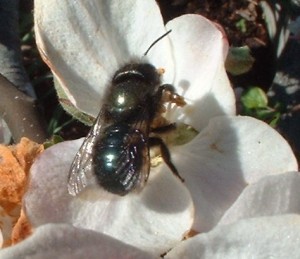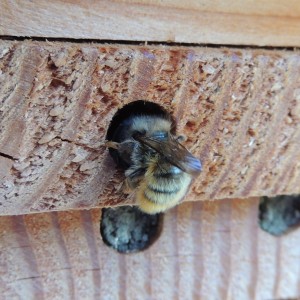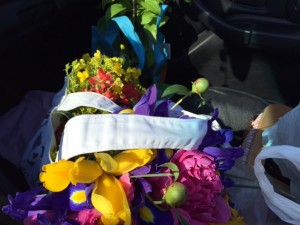
The bee house is up! As a beekeep wannabe from waaaay back (decades — really), I can’t begin to say how happy I am.
My beloved bought me a native bee house (not honey bees, more on this later) for the holidays. Health woes kept us from finishing it the way I wanted (he did, too), so it’s only now that it’s done. But boy, is it GREAT.
He bought the wooden bee ‘chalet’ from a wonderful source for native bees, Crown Bees, out of Washington state. Washington is a state that knows its bees, both native & honey. With a huge percentage of the nation’s apples & berries, pollination is a major concern. And of course, the Pacific Northwest is also home to a lot of fellow tree-huggers. 🙂
As any who know me will tell you, I’m crazy about bees. My first name means ‘bee’ in Hebrew, which has always meant something to me. I remember as a child reading Jean-Henri Fabre on bees, and being smitten. I would follow bees around the garden, a continuity that was rare in my pursuits, given how we moved. Bees, however, are everywhere. Well, except for Antarctica, and we weren’t ever stationeed there…;)

My uncle Russell kept bees, too. A quiet man, he would disappear into the garden and mess w/ his several hives. And sometimes there would be honey. It seemed the most wonderfully mysterious of natural miracles.
So at Christmas bee cocooons came — the way that native bees (this first set is mason bees, small jeweled powerhouses of energy: green & blue & black) make it over the winter. And a bee ‘chalet,’ and a lot of literature as well as a couple of pieces of help. We spent the early winter months talking about where ‘our bees’ would go. All too soon, it was spring. And time to put out bees.
Which meant a post to hold the bee house, and three (yep, THREE) different shipments of copper to find the right gauge for the roof. And a copper finial for the post, and then braces to set the now-heavy bee house on. And voilà! A gorgeous addition to environmentalism, on the local scale.

I’ve written a lot here about bees: my attachment to them, their Buddhist work ethic, even my first forays into keeping native bees. They are (to me) a kind of patron saint, or in the Buddhist parlance, a community of bodhisattvas: enlightened beings. They don’t sting unless provoked (unlike wasps!). They leave the world the sweeter for their work (all do — they pollinate — but honey bees even give us honey). And they’re so interesting.
Bees like me. I guess they can sense I’m not afraid, and I admire them. When I sit outside, they’ll come to me, settling on my hand and cleaning themselves. I never tire of watching them. They give me hope: even when I despair over human beings, and the ways in which we destroy each other, the bees remind me that there is more to the world than ugliness. More than hate and violence and death. There are bees.
Beginner’s heart. Both in my readying to welcome these amazing creatures, and in the wonder of observing their small lives. Looking out at the roses covering the fence around the high garden, and the clematis twining up the trellis, anticipating the various bee plants I’ve planted (echinacea, caryopteris, bee balm & sage & lavender & more), I’m content. It’s sometimes enough just to help someone else do what you can’t, on your own. And then watch as they succeed. It gives me hope.
So here’s National Poetry Month’s last poem, one about bees. And it’s a personal one — I wrote it, no famous poet. Just a bee lover, watching.
Blessed be the bees
Who work together
late October luminous in fall light
Caryopteris and rose
ageratum and lantana
arcs of light
Each pair of wings
frayed with time and distance
the homeward journey
over and over
Each time returning
to dance their own welcome

